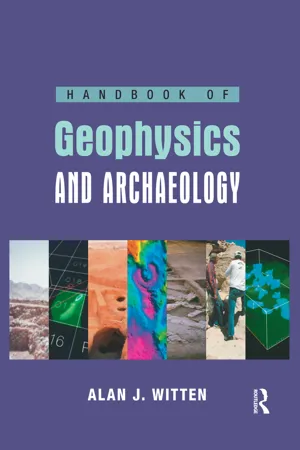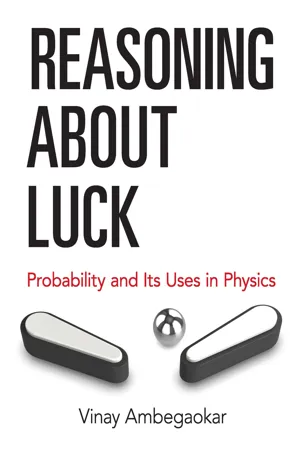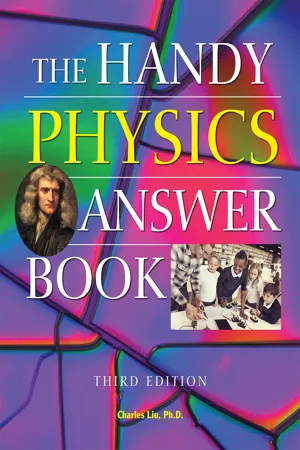Physics
Gravitational Acceleration
Gravitational acceleration refers to the acceleration experienced by an object due to the force of gravity. It is a constant value near the surface of the Earth, approximately 9.81 meters per second squared. This acceleration causes objects to fall towards the Earth at a consistent rate, regardless of their mass.
Written by Perlego with AI-assistance
Related key terms
6 Key excerpts on "Gravitational Acceleration"
- eBook - ePub
- AlanJoel Witten(Author)
- 2017(Publication Date)
- Routledge(Publisher)
Fig. 2.11 , can be implemented with a gravimeter. The only modification to this concept is that, like bathroom scales, gravimeters measure only the vertical component of gravitational force. It is now well known that forces are vectors and, since mass is a scalar, the direction of a force is along the direction of the acceleration. This makes acceleration a vector and, consequently, gravimeters only measure the vertical component of the Gravitational Acceleration. Figure 2.18a shows a gravimeter located directly above a localized region having a density different from its surroundings, △ρ, at a depth d below the ground surface. Recalling from Equation 2.13 thatΔ F = Δ ρ ,G m Vr 2where r is the distance from the density difference to the measurement, so thatΔF d= m Δ g = Δ ρ ,G m Vd 2and dividing both sides of this by the mass fixed to the gravimeter m yieldsEquation 2.18:Δ g ==ΔmF dΔ ρ ,G m Vd 2where △g is the measured change in Gravitational Acceleration. Because the direction of the change in Gravitational Acceleration is along the direction from the anomalous density to the measured point, in this case, △g is vertical. This could be vertically downward or vertically upward depending on whether the density change is positive or negative; however, the vertical component of the change in Gravitational Acceleration is equal to the change in Gravitational Acceleration, △gz= △g. When the measurement point is moved laterally away (Fig. 2.18b ), the change in gravitational force decreases as a result of the increased distance, from d to R, - eBook - ePub
- David Newman(Author)
- 2016(Publication Date)
- Routledge(Publisher)
PART IMechanics of GPassage contains an image
Chapter 1The Physics of Gravity
Humans exist in a gravity-dependent environment. In order to fully appreciate the physiological consequences of human exposure to high-gravitational forces, it is useful first to have a thorough understanding of what is meant by the terms gravity and acceleration, since they will be used frequently throughout this book. This chapter will examine the mathematics and physics underlying these important terms.Mechanics
Initially, it is helpful to define some important terms in mechanics that will be used repeatedly throughout this book. Speed is the term used to denote a change in distance with respect to time. It is a scalar quantity, reflecting magnitude only. When both the magnitude and direction of change in distance with time are considered, the term velocity is used rather than speed. Velocity is a vector quantity. When velocity experiences a rate of change with respect to time, acceleration is said to have occurred. It can also be thought of as the second derivative of distance with respect to time. Acceleration is of course also a vector quantity, having both magnitude and direction. The magnitude of acceleration, and the direction in which it is applied, will be examined in more detail in Chapter 2 .The terms speed, velocity, acceleration and force (to be discussed later with Newton’s Laws of Motion) are straightforward terms. Unfortunately, in many cases they are used interchangeably and in the wrong technical sense. This is worth briefly discussing, for the sake of clarity. Speed and velocity are often used to represent the same thing, which as has been seen above, is not technically correct. One is a scalar quantity, the other is a vector. In many cases, speed is used when velocity might be the more correct term. In the lexicon of acceleration physiology, the terms force and acceleration are also very often used interchangeably. This can create some confusion on the part of readers, particularly those new to the field. The situation is made worse when the terms G force and G acceleration are used on an interchangeable basis. Ultimately, it does not matter which term is used, as long as there is some consistency. As readers will see in later sections of this chapter, the interchangeable use of force and acceleration is a by-product of one of Newton’s Laws of Motion – force and acceleration are proportional to each other. In this book, the term G force will be used to represent the force applied to a body undergoing an acceleration. This will become clearer as this chapter develops. - eBook - ePub
- Morris Kline(Author)
- 2013(Publication Date)
- Dover Publications(Publisher)
2 . This formula expresses the dependence of the gravitational force between two fixed masses on the distance between them.Newton had yet to show that formula (2) was the correct quantitative expression for this force. To apply formula (2) and to work with forces in general, Newton adopted a second quantitative physical principle which proved to be just as important as his law of gravitation. As we noted in the preceding section, near the surface of the earth the force of gravity of the earth gives to objects an acceleration of 32 ft/sec2 , and the force is 32 times the mass of the object. Newton generalized this relationship and affirmed that whenever any force acts on an object it gives that object an acceleration. Moreover, the relationship of force, mass of the object, and acceleration imparted to the object, isIn this formula F is the amount of force applied to the object of mass m , and a is the amount of acceleration imparted to the object. In the special case where F is the weight w , the value of a is 32 ft/sec2 . Formula (3) is known as Newton’s second law of motion. It applies to any force, whether or not it be the force of gravity. As in the case of formula (1) , if m is measured in pounds and a in feet and seconds, then F is measured in poundals. Thus a force of 32 poundals gives a mass of 1 pound an acceleration of 32 ft/sec2 . The unit, pound, is also used for forces with the understanding that one pound of force equals 32 poundals.Let us see how Newton tested his law of gravitation. We shall write (2) in the slightly different formIf we compare (3) and (4) , we observe that the quantity GM /r 2 in (4) plays the role of a in (3) ; that is, the law of gravitation can be viewed as stating that the gravitational force F gives a mass m the acceleration GM /r 2 . In symbols,Now let M be the mass of the earth and let m be the mass of a small body near the surface of the earth. Then there is the question of what r in (5) represents. It is supposed to represent the distance between the two masses. Shall we take it then to be the distance from the mass m to the surface of the earth or to some point in the interior? If the two masses were separated by millions of miles, as are the earth and sun, one might idealize each mass and regard it as concentrated at one point because the size of each mass is small compared with the distance between them. But for objects near the surface of the earth, the value of r depends heavily upon what point in or on the surface of the earth is chosen as the position of the earth. Newton conjectured (and later proved) that for purposes of gravitational attraction the mass of the earth could be regarded as though it were concentrated at the earth’s center. Hence, with respect to the earth’s Gravitational Acceleration acting on a mass m near the surface of the earth, r in (5) can be taken to be 4000 miles or 21,120,000 feet. This value of r is essentially the same for all objects near the surface of the earth. Moreover, the mass M of the earth is constant, and so is G . Hence, for all objects near the surface of the earth, the entire right side of (5) is constant. Consequently, the acceleration which gravity imparts to all objects near the surface of the earth is constant. This is precisely what Galileo had found and, in fact, he had determined that the constant is 32 ft/sec2 - eBook - ePub
- Vinay Ambegaokar(Author)
- 2017(Publication Date)
- Dover Publications(Publisher)
It is worth pointing out that this constant can be measured in the laboratory ‡ by measuring the force between massive objects. The constant is found to be 6.67×10 –11 in mks units – force in newtons, distances in meters, and masses in kilograms. It is then fascinating that the equation for the acceleration due to gravity, g, obtained by eliminating F a from (6.9) and (6.11), allows one to calculate the mass of the earth from its radius, the acceleration due to gravity, and the gravitational constant! The answer is close to 6×10 24 Kg. Newton’s mechanics not only explained the motion of ordinary objects on the earth, and of celestial bodies, but it left as a more general legacy the concept of Energy, which turns out to be central to a discussion of heat. To this we now turn. Energy When an apple is falling towards the earth, nothing about its state of motion appears, at first sight, to be remaining the same. Its velocity, after all, is increasing, and its height above the surface of the earth is decreasing as time passes. It is, however, possible to view the fall of the apple as a process in which something called energy is being changed from one form to another, while itself remaining constant. Energy is one of what are called ‘constants of the motion’ in Newton’s mechanics. Abstract and perhaps artificial though this concept seems, energy has become a common thread that runs through all branches of physics. It is possible to view each great advance in our understanding of the physical world since Newton’s time as the identification of a new form of energy - eBook - ePub
- Charles Liu(Author)
- 2020(Publication Date)
- Visible Ink Press(Publisher)
G is the symbol for the universal gravitational constant. It is called universal because it is the same for objects made of any material and of any mass—from an apple to a galaxy.The equation that describes the gravitational field at a specific location isIf the sun suddenly disappeared, what would happen to the sun’s gravity?W hat would happen to Earth if the sun suddenly disappeared? How soon would Earth recognize that the sun’s gravitational field was gone? It couldn’t happen instantaneously because according to Einstein’s Special Theory of Relativity, no information can travel faster than the speed of light. It would take about eight minutes before Earth would both experience the lack of sunlight and the lack of gravitational force at the same time.g = −GM/r2Here, M is the mass of the attracting object, and r is the distance from the center of this mass to the location in space. The gravitational field is a vector quantity, and its direction is toward the center of the attracting object.What is the difference between a gravitational field and Gravitational Acceleration?
When Isaac Newton developed his Universal Law of Gravitation, nobody had yet understood the concept of a gravitational field. Instead, Newton found g = −GM/r2 to be the acceleration of an object by another object due to the force of gravity. About 200 years after Newton’s work, Albert Einstein developed the General Theory of Relativity; one part of that theory is called the Principle of Equivalence, which explains that you cannot tell the difference between being accelerated by a pulling force and being acted upon by gravity.How does a gravitational field relate to force?
According to Newton’s Second Law of Motion, the force exerted on an object is equal to the object’s mass times its acceleration. Because of the Principle of Equivalence, it is appropriate to say that the force of gravity on an object is equal to the object’s mass times the gravitational field strength or, written as an equation, F = mg = −GMm/r2 - eBook - ePub
- C. S. Unnikrishnan(Author)
- 2022(Publication Date)
- Jenny Stanford Publishing(Publisher)
This depends on the ratio of the gravitational mass and the inertial mass. However, if the property of inertia is the same physical quantity as the gravitational charge, we get the universality of the Gravitational Acceleration(2.12)a →=g →=m gm ig →In fact, for the Universality of Free Fall, it will suffice if the ratio of the two quantities, mg / mi , is the same for all bodies, independent of the material properties.The fundamental puzzle of why the inertia is universally related to the gravitational mass was never solved. It was finally sidelined by Einstein by assuming or postulating that the two quantities ‘mass’ and ‘inertia, which could have been fundamentally different, are in fact the same. This is the Weak Equivalence Principle, which asserts the equivalence of the gravitational mass and the inertial mass. Einstein was a master of transforming a riddle into a worthy principle and then using it to derive new physics. Generalizing from the consequence of this, Einstein stated that a gravitational fieldand an accelerationg →generated by any means cannot be distinguished ‘locally’ with experiments within the local region. When stated in this general form, it is called the Einstein Equivalence Principle and it is the fundamental hypothesis and basis on which his theory of gravity, the General Theory of Relativity, is built.a →= −g →Einstein wrote in 1914 (Physical foundations of a theory of gravitation) (Einstein, 1914),It is one of the most remarkable empirical facts of physics that these two masses, the inertial and the gravitational, agree exactly with each other as regards their magnitude...In a gravitational field all bodies fall with the same acceleration. This suggests the view that, with regard to its influence on mechanical and other physical processes, a gravitational field may be replaced by a state of acceleration of the reference body (coordinate system). This conception does not follow with necessity from the experiments mentioned, but it is of great heuristic interest all the same. For, since the course of physical processes relative to an accelerated reference system can be determined theoretically, this equivalence hypothesis
Index pages curate the most relevant extracts from our library of academic textbooks. They’ve been created using an in-house natural language model (NLM), each adding context and meaning to key research topics.





